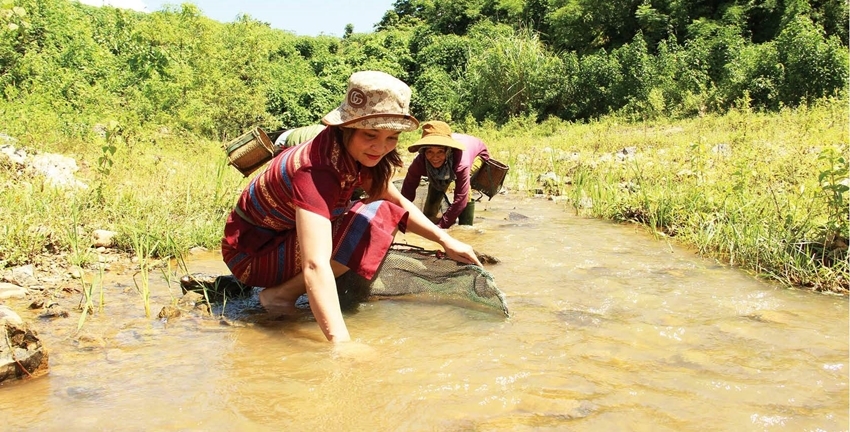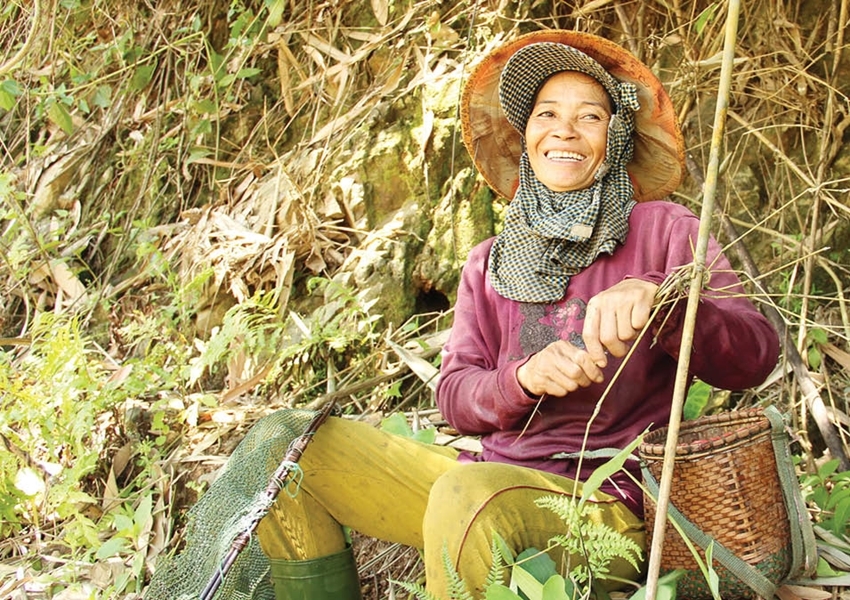Sweat soaked the back of her old shirt woven from traditional zèng fabric, dripping on her rosy cheeks glowing in the sun. Her smile was bright like the sun and as rustic and gentle as the forest leaves. So beautiful was the “picture” that we could not help but “fix” the appointment to move upstream.
 |
| Engrossed in work |
Sweat and joy
When the fluffy white clouds surrounding the foot of the mountain gradually melted away, the golden sunlight filtered through the treetops, overflowing downstream in the dry season. It was also the time when we followed the Pa Co women up Tan Tung Stream (flowing through Hong Thuy Commune) to hunt goby.
“This season, the stream water is still shallow. Goby are in great abundance; their meat is yellow, delicious, sweeter, and fatter than other times.” Kan Dat, a woman under 30, with a ka ria (a bamboo or rattan-woven container of fish) on her hip, smiled and said softly, “Let’s go.” Ms. Hoang Thi Dung (the same age as Kan Dat) and Ms. Nguyen Thi Dia (over 60) also carried tools and quickly walked. The murmur of water flowing through each rock blended with the whistle of mountain wind was like a bustling melody of the mountains and forests, encouraging the hard-working feet.
 |
| Collecting each "batch" of fish |
Kan Dat said the Pa Co people use a noc to catch stream fish. It is a round racket with a mouth about as wide as an adult's arm span, woven with a net and a handle. Sometimes, they also use a nua - a tool woven from bamboo to scoop fish. When scooped up, the fish must be kept in ka ria so that the freshness of the fish can be preserved longer. "If kept in a bucket or basin, the fish will die and spoil faster. The delicious taste of fish will also decrease. Our people weave ka ria from bamboo and rattan cut in the forest. The bamboo strips woven together have vents, so even without water, the fish will still die very slowly," Kan Dat explained.
After choosing a rocky stream, and placing the a noc on the stream bed, all three people chased the fish and turned over all the rocks to drive the fish into the a noc. The women worked at full stretch upstream, meticulously turning over each stream rock so that the fish had no place to hide. The clear stream water turned red with mud.
 |
| A break by the stream |
Lifting the net high, Kan Dat and his "colleagues" looked delighted with their achievement. Big and small goby... jumped up and down at the bottom of the net. Pouring the fish into the ka ria worn at their hips, the Pa Co women continued to move upstream, place the net, turn over rocks, and chase the fish. By noon, when the sun came into view on the mountain, the backs of their shirts were soaked, and the ka rias were also "quite heavy" with stream fish, most of which were fresh goby leaping up and down.
Kan Dat has another job. Dung and Dia also work mainly in the mountain fields: growing rice, corn, and cassava. When not busy at the field, they go to the stream to catch fish. Usually, on weekends, Kan Dat will join in catching goby to improve the family meals. Whenever the harvest is large, people will "go online" to sell for more income.
 |
| Fruit of a day |
These women often choose familiar streams near their houses, but they also frequently "hunt" fish at distant streams. Xo Xa, Xo Tong, Xo A Rai, Da Karong streams ... all bear the hard-working footprints of highland women. 1kg of stream goby costs 150,000 VND. Working hard on the winding streams, from morning until noon, each lucky person can catch 1 to 2 kg of fish. "When I post on Facebook, my friends and acquaintances usually order all of them, and I deliver the fish to them. It's so much fun at such times. I’m overjoyed to earn an extra income and that everyone can eat fresh fish from nature," Kan Dat shared with a lovely smile.
Gift of life
The stream goby is a gift from nature that the winding streams flowing from the jungle offer to the residents in the old forests at the foot of the Truong Son mountain range. In the fresh water, the stream goby grows up by eating moss clinging to the rocks, so the meat is sweet, fragrant, and tough. The big goby is as big as a thumb, and the small one is as big as a chopstick tip. The stream goby is seen as a specialty of the highland forests. This type of fish has a lot of meat and few bones. Its bones are very soft; the meat is tough and sweet and can be processed into many delicious dishes. Aside from grilling in leaves, grilling in tubes, and cooking in sour soup, the Pa Co people often braise stream goby with wild chili, wild pepper, a little sugar, and cooking oil... How fantastic eating white rice with that delicious dish is!
Most of the ethnic minorities living in forests and streams can catch stream fish. According to Mrs. Dia, stream goby grilled in bamboo tubes and leaves are often used in festivals such as the new rice celebration or the wedding ceremony of the Pa Co people. In the old days, when distinguished guests came to the house, the son-in-law visited the house, or the groom's family visited the bride's family to propose marriage, the Pa Co people respectfully invited guests to enjoy stream goby to show their affection and hospitality. "That is the beauty of the Pa Co people," said Mrs. Dia.
In summer, from noon, there are often thunderstorms. In A Luoi mountainous areas, thunder and lightning frequently come into sight. To avoid danger, people who go to streams to catch goby often choose to go in the morning. "July and August are the times when goby fish are most abundant. Because this type of fish reproduces and grows quickly in the wild, they lay eggs all year round, but the end of summer is when the fish have the most eggs and are the fattest of the year," Ms. Hoang Thi Dung added.
In Ms. Dung's experience, stream goby has the habit of hiding under new rock holes, so after the goby hunters turn over all the rocks, the goby will soon return to those places in large numbers. Therefore, every day, they walk from one stream to another, but the fish never run out. "We scoop the fish by hand. When the fish are scooped away, the eggs hatch into baby fish, and the baby fish continue to grow. The cycle repeats itself over and over again, so fish cannot be exhausted. If fish are caught with electric shock, even the eggs will die. Electrocuted fish are unpleasant to eat because they are not fresh. Importantly, the people currently abide by the government's propaganda against catching fish with electric shock to protect the habitat of fish and cause no danger to themselves," Ms. Dung confided.
The dry season is followed by the rainy one. The stream water rises. The stream goby cannot withstand the rushing current. Afraid of being swept away by the strong water force, they will all drift to both sides of the bank. Without turning over rocks to chase fish, goby hunters walk along the stream bank, using tools to "pick them up" and scoop up.
According to Ms. Nguyen Thi Tu (working at the Sub-department of Education and Training of A Luoi District), currently, not only do the people have tools at home and get goby-hunting jobs to increase their income, but some officers and public employees in the area also picnic by the stream, "hunt" fish upstream every weekend. It is like the mental pabulum of life.